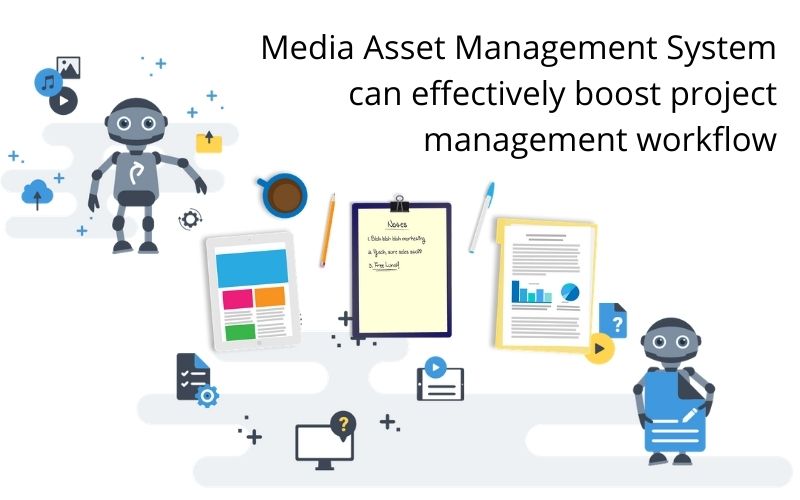As a creative director or manager, it’s not strange to receive multiple requests from colleagues for a most recent version of a media asset like a logo. This is a big headache. Not to mention the time spent converting files between formats.
Imagine a world where you would not need to manually perform these mundane tasks, and instead focus on your core creative work. With a media asset management (MAM) solution, it is possible to tap into these capabilities.
8 reasons why every creative director needs a media asset management system
- Workflow bottlenecks
- Easy project management
- Brand consistency
- Accessibility
- Usage rights
- Collaboration
- Integrations
- Control revision history
Remove workflow bottlenecks
Media asset management gives creative directors an opportunity to save time spent looking for, reformatting and sending over media assets to colleagues. Creative departments notice that once they do their first MAM deployment or upgrade, workflow processes across the team and departments are greatly speeded up. Creative directors are also able to share work-in-progress in real-time without delayed file transfers in the system.
For example, during a photoshoot, a field photographer could upload photos to the system with all the metadata automatically updated. Production editors in the office can review and comment on the work in progress. Once approved, production artists will work on them and hand them over to the designers and editors for final processing.
Hence digital media asset management removes the need to wait for meetings for collaborators to update each other. Creative assets are seamlessly shared across departments, organizations, different time zones and locations.
Easy project management for numerous clients
Creative managers, especially from agencies service a lot of clients at once. This means they juggle libraries of media assets and have to adhere to different project timelines. This can be daunting to keep track of. Furthermore, using outdated methods such as email, shared folders and FTP may lead to confusion and important information being left out or lost. 
A MAM system solves this problem by providing a seamless way to share work with clients and receive feedback and approvals. With the permission’s capability, creative directors are also able to share with clients only what is meant for them.
Brand consistency
With digital MAM, creative directors are able to set up and organize brand assets such as brand guidelines, logos, images, videos and other branding material in a centralized place. All up-to-date and current versions are clearly labelled to ensure consistency.
Everybody who might need these assets is granted access; colleagues, media outlets, brand partners and vendors. Not only does this create brand consistency, but it also makes work easier for everybody involved in creative projects such as events, promotions and press releases.
Access design files anywhere via cloud storage
For creative directors such as photographers and filmmakers, often they will be needed to work away from the office. This could be on the field, pitching to a new client, travelling, or working remotely.
A digital MAM system allows you to store your entire creative asset in the cloud, and access them from anywhere. This eliminates the need to carry your work machine, physical flash sticks or hard drives; that are susceptible to lose, damage or theft.
What’s more, media asset management allows you to store your files in a variety of accessible formats that you can preview before you download from your offsite location.
Manage usage rights and ensure legal compliance
Most creative assets such as stock photography, original photography and outsourced logos usually have privacy and licensing guidelines attached to them. Media asset management will allow you to store this kind of copyright information, by attaching licensing or copyright agreement to an asset or a group of assets. This way, any user accessing a media asset is able to view its usage restrictions and abide by them.
The MAM system also gives you the ability to put restrictions on who can access what assets. For example, you can restrict stock photos for internal team usage only. This MAM capability will protect the creative director and the team from infringing asset ownership rights and facing lawsuits for contravening agreements.
Collaborate with other designers without having to email large files
Constantly emailing large files to your creative team is so 19th century. A MAM system allows you to add files to a collection and simply share a link with your colleagues for review or download.
This method of file sharing also allows for collaborators to add comments and questions directly on the collection without the need for separate email threads. The result is efficient and fast-completed projects.
Allows for integrations
MAM systems have become instrumental in the operations of large creative agencies and organizations with creative departments. It is now possible to hook them into e-commerce systems such as Magento, ERPs like SAP, and collaboration systems like Sharepoint and creative workflow tools like InMotionNow.
Other MAM systems allow for database mounting to Adobe Bridge, allowing all tools that work with Bridge to access all files directly. This includes Photoshop, Illustrator, Premiere Pro and the like. Some MAM systems also have drag and drop capabilities into Adobe InDesign, while some superior systems allow assets to be automatically linked and two-way communication with InDesign projects
These integrations go a long way in making production processes and creative development easier and faster. For example, Publitio Media asset management system allows you to integrate with frameworks of your choice.
Control revision history using asset versioning
Media Asset management allows you to upload a file that you have made changes to as a new version. The file name and number stays the same, and all its metadata is retained. The asset also remains in all the collections it previously existed in and all links to the asset stay active. The MAM system allows the creative director or anyone who has access to the file to roll it back to a previous version if needed.
Asset versioning in media asset management ensures creative directors are always working with the most recent version of an asset while allowing you to track changes made over time.
Final word
It is evident that digital media asset management offers numerous benefits to a creative director. This is especially as the demand for rich engaging content is on the rise. From increased productivity, asset protection, saving time and tracking usage rights, a MAM should be a priority for any creative agency or any company’s creative department.
All said and done, would you like to empower your media?




